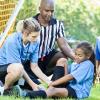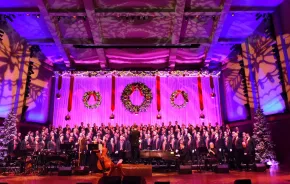
Photo:
The author’s daughter tries shooting on goal at “Hockey: Faster Than Ever” at Seattle’s Pacific Science Center. Credit: Natasha Dillinger
I’ll be honest, we’re not a sports-focused household, but the buzz around the new Seattle Kraken hockey team is infectious. We’ve skated at the new training rink, toured fancy new Climate Pledge Arena on community day and looked forward to the Pacific Science Center’s new exhibit called “Hockey: Faster Than Ever.”
But I still had some doubts as we headed over to check it out. Would a family with little hockey experience enjoy an entire exhibition focused on the sport? We set off to find out.
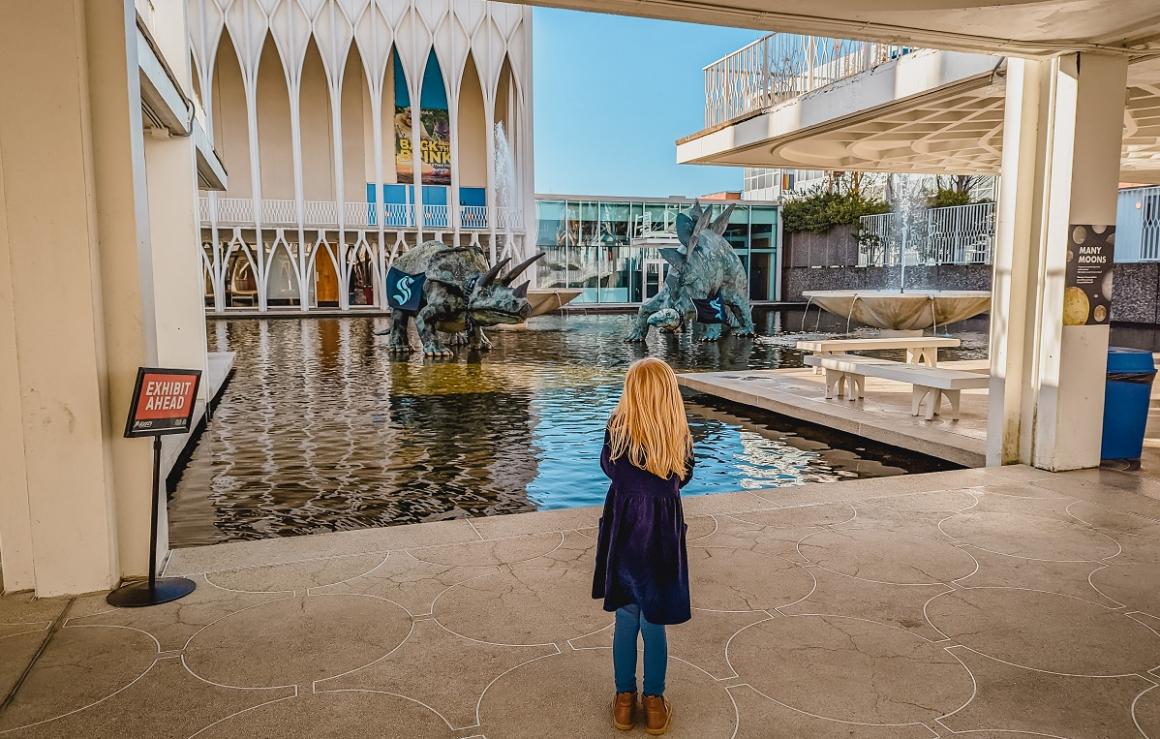
Spoiler alert: My kids had trouble picking their favorite part!
Hockey 101: rules of the game
After grabbing a “play card” (similar to a scavenger hunt) near the exhibit entrance, we spent a few minutes looking at the cases of historical hockey equipment. Early players may have used frozen cow dung as a puck, which delighted my toilet-talk-obsessed kids to no end. A nearby display detailed women’s entry into hockey in the late 1800s, perhaps propelled by the fact that corsets weren’t required on the ice — that would definitely have enticed me to join in!
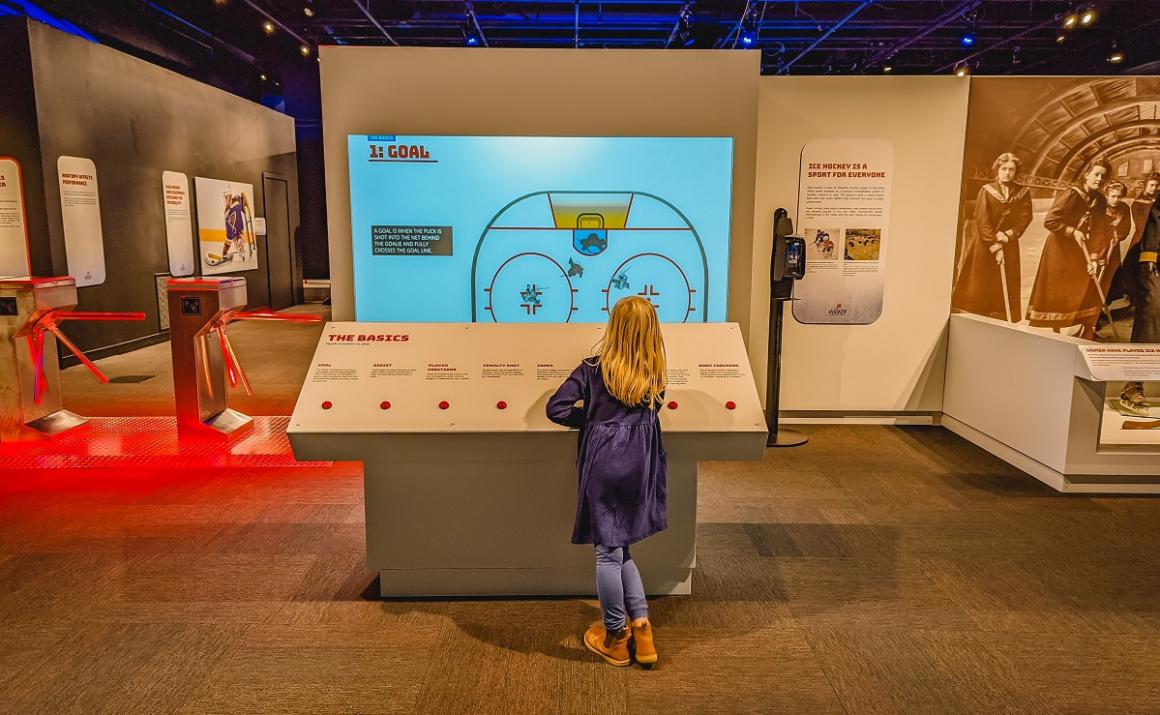
For us hockey newbies, there’s an interactive screen that covers a handful of hockey basics — including goals, player positions and rink zones — with animated demonstrations to make it easy to understand.
To reinforce our new knowledge, we headed over to the “Be the Ref” exhibit to observe players in action and help call which rule they had broken. My kindergartener loved this activity and I thought it was a great reminder that even grown-ups get penalties when they break the rules.
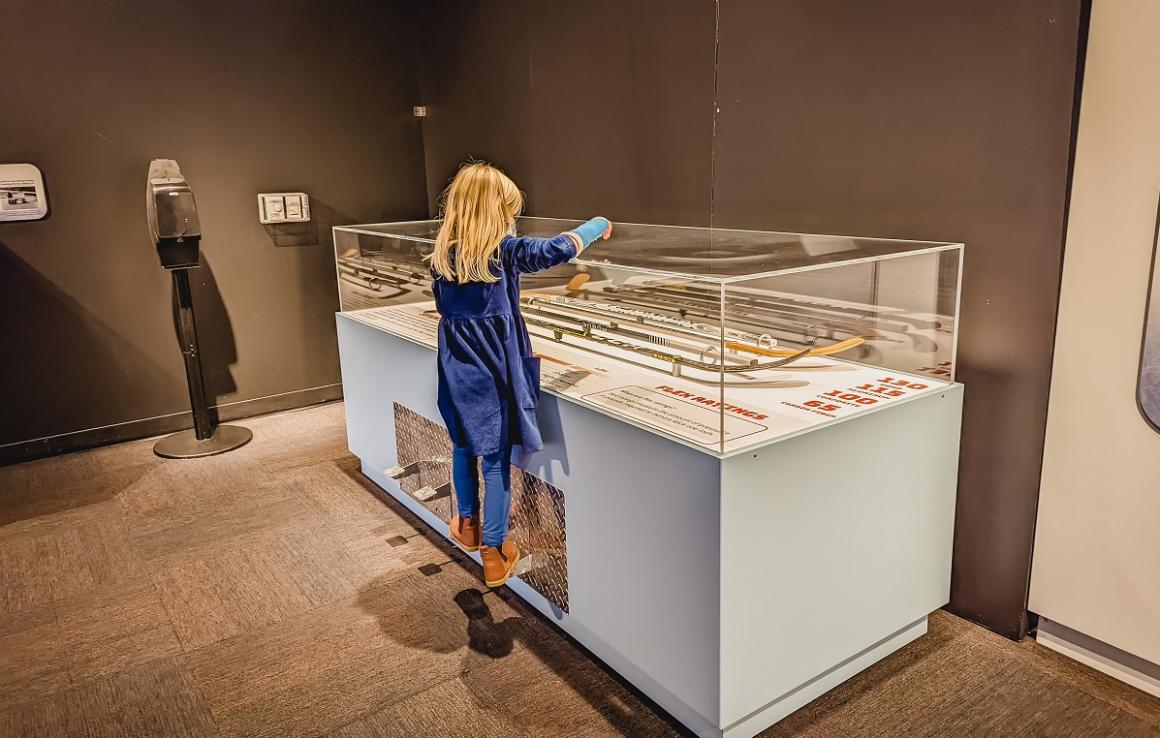
Science in action
It wouldn’t be the Pacific Science Center without STEM learning opportunities. The textbook definitions of potential and kinetic energy would go way over my 5-year-old’s head. But as she stepped on foot pedals to test the flexibility of different hockey stick materials and watched a video of a slow-motion swing, it was easier to understand how a more flexible stick would carry more potential energy, similar to stretching a rubber band. I was impressed at how the accessible format meant my daughter didn’t shy away from big concepts.
Hockey players in their giant pads don’t exactly scream “grace,” but wobbling on balance boards and sleds helped show us how keen agility is needed to block passes on skinny skates. We also loved a shuffleboard-like game that focused on how freezing temperatures keep pucks and skates moving quickly across the ice.
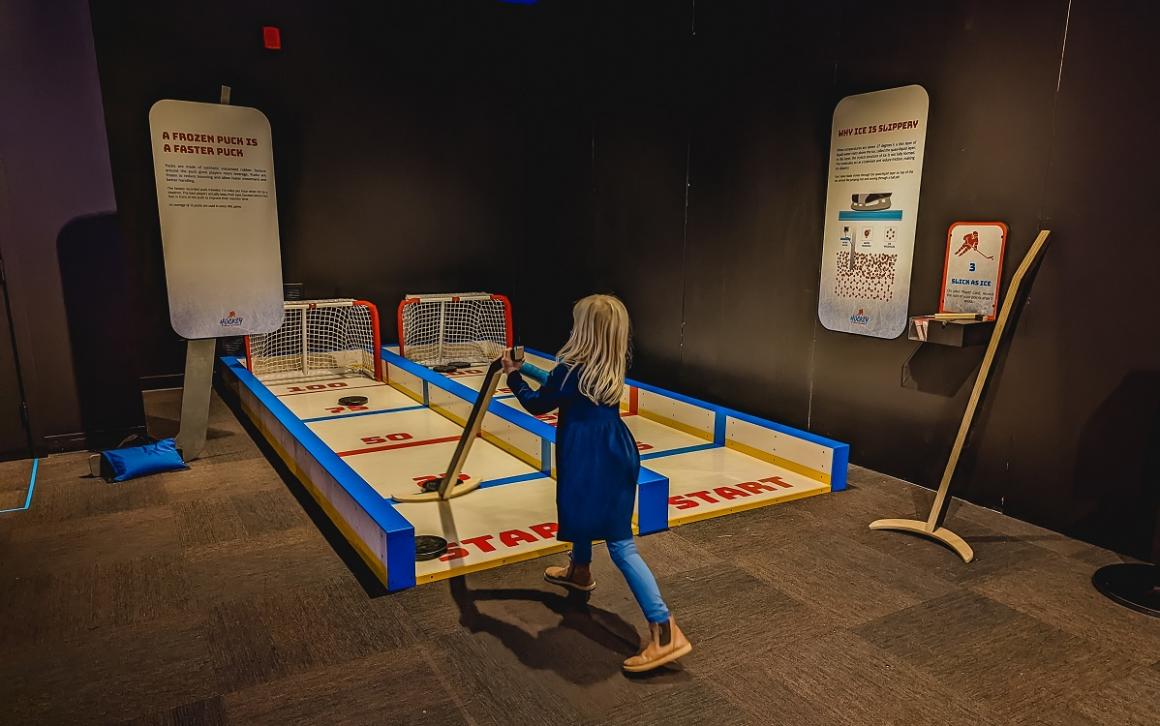
Time for hockey practice!
When you visit, save the most time for the action-packed third room on the bottom floor (just past the locker-room-style display of uniforms). My kids never wanted to leave! At the shooting cages, we whacked soft pucks towards sensors that measured the speed of our goal shots. The pros manage to hit pucks upwards of 100 miles per hour, but wielding a stick taller than he is, my toddler felt pretty proud of his 10-mile-per-hour hit.

A light-up board resembling whack-a-mole helped us test our goalie reflexes. The game was a great exercise in teamwork since my 2-year-old needed his big sister’s help to reach the uppermost buttons.
I even joined in on the excitement — moms are famous for our quick reflexes and I had a reputation to uphold. With such fun hands-on exhibits, I could see this area getting a little crowded on busy weekends and would consider bringing an extra adult as a line place-holder.
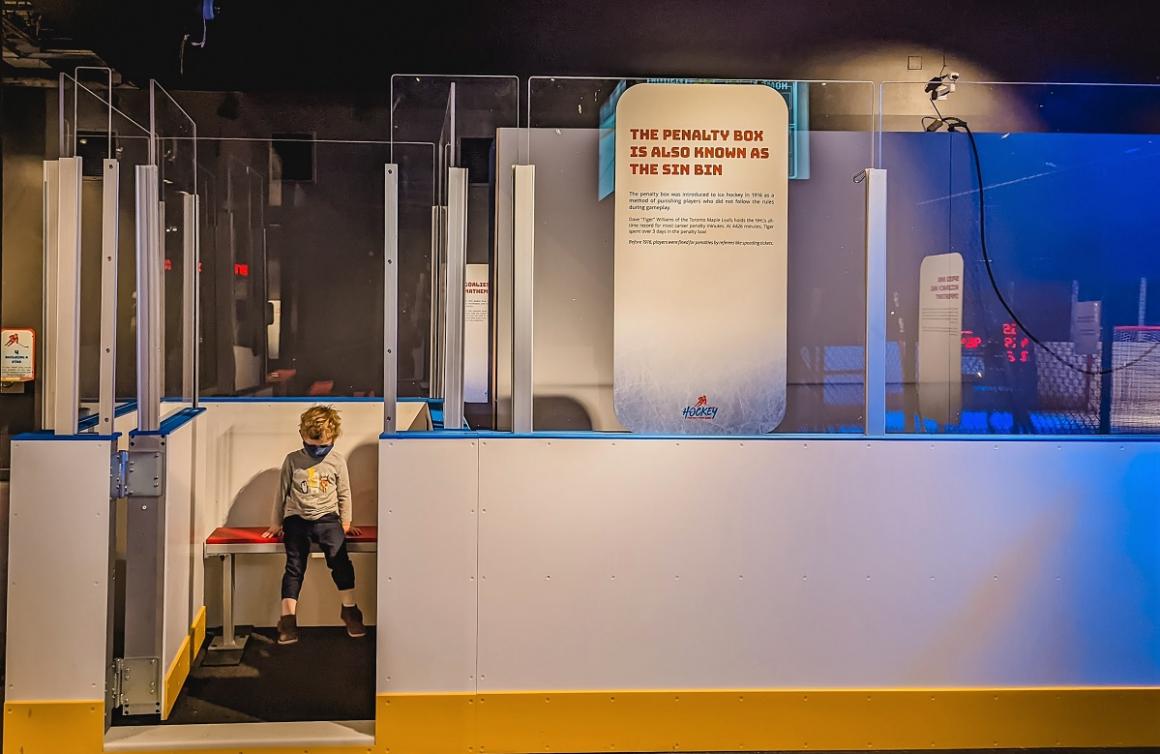
Before heading upstairs, we took a peek at the mock penalty box, also known as the “sin bin.” Dave “Tiger” Williams, a former Toronto Maple Leafs player, spent over 4,400 minutes (more than three days!) in the box over the course of his career. That makes any time-outs I give my kids look like literal child’s play.
But wait, there’s more
As we headed up the ramp to the top floor, I assumed we’d hit a gift shop and the exit, but there were several more exhibits to see. A goalie shootout game covered the concept of angles as we tried to predict where to block a player’s goal shot. It was a little bit too challenging for my daughter, who opted to join her brother at the foosball-like bubble hockey table. A friendly staff member gave them tips and tricks and my two-year-old even managed to score a couple of lucky goals.
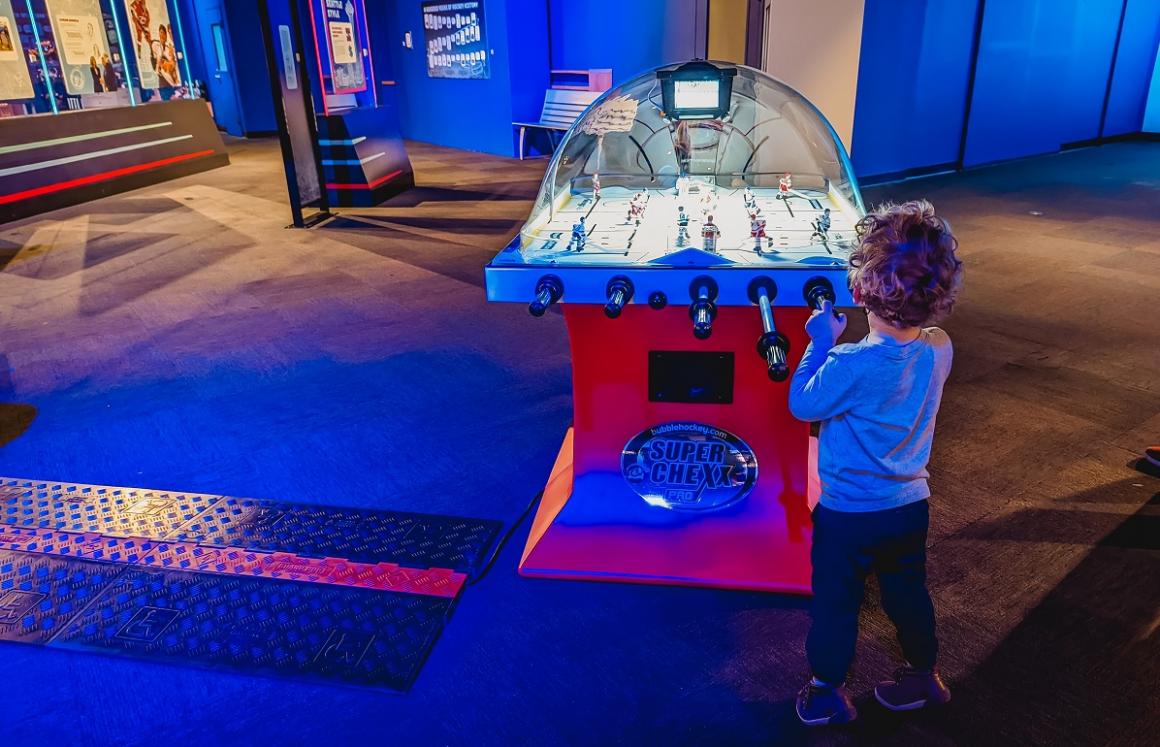
Bubble hockey kept my kids entertained long enough for me to peruse the informational displays. One of the things I appreciated about the exhibit (and the Kraken franchise in general) is the movement towards inclusiveness and diversity. There are exhibits covering sled hockey, which started in the 1960s, and which allows people with disabilities to play hockey by using metal picks to propel sleds across the ice. Likewise, the contributions of female players, coaches and scouts are highlighted throughout the exhibition. Ramps, wide pathways and displays at wheelchair-friendly heights help make the space more accessible to everyone.
Over 20 hands-on activities make it easy to learn through play and families like ours can flex concepts up and down to make them age-appropriate. While perhaps best-suited to elementary and middle school-aged students, my kids found plenty to love at this exhibit. I’m already recommending it to friends as a great addition to a day at Seattle Center.
If you go…Find it: Pacific Science Center is located on the Seattle Center campus at 200 2nd Ave. N. in Seattle. Use the north entrance to the Science Center (across from the Seattle Children’s Theater) for this exhibit. (Note that the rest of Pacific Science Center remains closed; this is a standalone exhibit.) Hours: The exhibit is open now and runs through Feb. 27, 2022 (closed on Thanksgiving and Christmas Day). Book your timed entry tickets online, with times available from noon–7:15 p.m. on weekdays and 10 a.m.–5:15 p.m. on weekends. The online ticketing portal tells you how many tickets are left, so you can pick a less busy time if you want to avoid crowds. Cost: $24.95 for adults (ages 16 and older), $22.50 for seniors over 65, and $17.50 for youth ages 3-15. Kids 2 and under are free. Discounts are available for museum members and military. Deeper discounts can be requested by anyone who qualifies for the museum’s Access Membership program (see example criteria here). Parking and transit: Several garages offer parking nearby. The closest is the Claypool Garage at 2nd Ave. N. and Denny Way, where you can expect to pay about $13 for up to five hours of parking. Limited street parking is less expensive. We like to take the Monorail from downtown, where we can connect with buses and Link light rail. Facilities: There are no restrooms in the exhibit, so plan to use the restrooms (where the murals provide fun facts about poop — every parent’s dream) before entering. No food or drink are allowed in the exhibit, but families can snack outside near the pond area. COVID protocols: Masks are required for everyone ages 2 and older, regardless of vaccination status. Proof of vaccination or a negative PCR test within 72 hours is required for guests ages 12 and over. Nearby: You’ll find plenty of food options in the Armory building and kids of all ages love the unique and thrilling Artists at Play playground near the Monorail station. |





